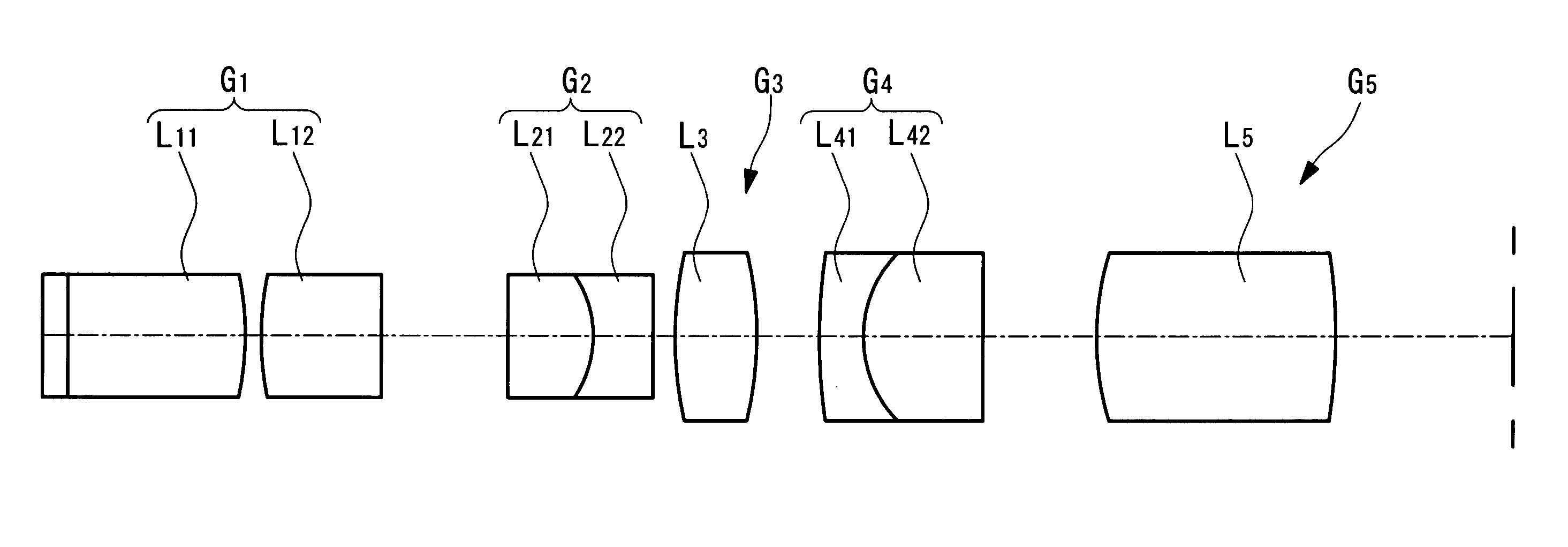Compact objective optical system and examination apparatus
a technology of objective optical system and objective lens, which is applied in the field of compact objective optical system, can solve the problems of inability to carry out long-term examination, large incision in living organism, and high invasiveness, and achieves wide observation range, long length, and overall length increase
- Summary
- Abstract
- Description
- Claims
- Application Information
AI Technical Summary
Benefits of technology
Problems solved by technology
Method used
Image
Examples
first example
[0120]FIG. 4 shows the lens arrangement of a first Example of the compact objective optical system 1, and Table 1 shows lens data of the compact objective optical system 1 according to this Example. FIGS. 5A to 5F show aberration plots for the compact objective optical system 1 of this Example. FIG. 5A shows spherical aberration, FIG. 5B shows astigmatism, FIG. 5C shows distortion, FIG. 5D shows lateral chromatic aberration, and FIGS. 5E and 5F show comatic aberrations. In FIGS. 5A to 5F, symbol NA indicates the numerical aperture at the image side, symbol y indicates the image height, symbol M indicates the meridional plane, and symbol S indicates the sagittal plane. The lateral chromatic aberration shown in FIG. 5 is based on the d-line (587.56 nm).
[0121]
TABLE 1SURFACENUMBERrdnν1∞0.21.3330455.89(OBJECT(WATER)SURFACE)2∞1.511.5163364.143−3.0020.13142.25611.613444.275∞1.0816∞0.711.4387594.937−0.9420.51.613444.278∞0.2192.9080.71.5163364.1410−2.9080.551114.8270.361.772549.6120.94211.67...
second example
[0125]Next, a second Example of the compact objective optical system 1 will be described below.
[0126]FIG. 6 shows the lens arrangement of the compact objective optical system 1 according to this Example, and Table 2 shows the lens data of the compact objective optical system 1 according to this Example. FIGS. 7A to 7F are aberration plots for the compact objective optical system 1 of this Example. FIG. 7A shows the spherical aberration, FIG. 7B shows astigmatism, FIG. 7C shows distortion, FIG. 7D shows lateral chromatic aberration, and FIGS. 7E and 7F show comatic aberrations. The symbols in FIGS. 7A to 7F are the same as those in the first Example.
[0127]
TABLE 2SURFACENUMBERrdnν1∞0.21.3330455.89(OBJECT(WATER)SURFACE)2∞1.661.5163364.143−3.1020.33143.2812.51.613444.275∞0.1516∞11.4387594.937−0.9420.511.613444.278INF0.4193.1020.71.5163364.1410−3.1020.551111.9610.361.772549.6120.94211.5163364.1413∞0.99114∞1.51.5163364.1415−2.3851.43116∞(IMAGINARYSURFACE)
[0128]The compact objective optica...
third example
[0131]Next, a third Example of the compact objective optical system 1 will be described below.
[0132]FIG. 8 shows the lens arrangement of the compact objective optical system 1 according to this Example, and Table 3 shows the lens data for the compact objective optical system 1 according to this Example. FIGS. 9A to 9F show aberration plots for the compact objective optical system 1 of this Example. FIG. 9A shows spherical aberration, FIG. 9B shows astigmatism, FIG. 9C shows distortion, FIG. 9D shows lateral chromatic aberration, and FIGS. 9E and 9F show comatic aberrations. The symbols in FIGS. 9A to 9F are the same as those in the first Example.
[0133]
TABLE 3SURFACENUMBERrdnν1∞0.11.3330455.79(OBJECT(WATER)SURFACE)2∞0.341.5163364.143∞(PRISM)11.772549.64∞0.51.772549.65−4.480.13162.25611.613444.277∞1.0818∞0.711.4387594.939−0.9420.51.613444.2710∞0.21112.9080.71.5163364.1412−2.9080.551134.8270.361.772549.6140.94211.677955.3415∞0.991162.53221.5163364.1417−8.4561.51118∞(IMAGINARYSURFACE)
[0...
PUM
 Login to View More
Login to View More Abstract
Description
Claims
Application Information
 Login to View More
Login to View More - R&D
- Intellectual Property
- Life Sciences
- Materials
- Tech Scout
- Unparalleled Data Quality
- Higher Quality Content
- 60% Fewer Hallucinations
Browse by: Latest US Patents, China's latest patents, Technical Efficacy Thesaurus, Application Domain, Technology Topic, Popular Technical Reports.
© 2025 PatSnap. All rights reserved.Legal|Privacy policy|Modern Slavery Act Transparency Statement|Sitemap|About US| Contact US: help@patsnap.com



